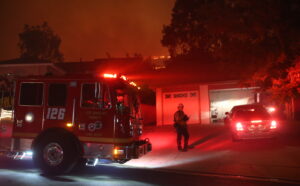For many of us, the only time we’ll venture out into stormy weather is when we have to get on the road. That means, we need to get our car ready for El Niño rains, and the treacherous driving conditions that go with them. Now, you can’t do much about Mother Nature’s fury, or the lousy driving of your fellow commuters, but you can control how prepared you and your car are for wet weather driving.
Automotive experts tell us the most important safety factors for driving in inclement weather are traction, braking, vision and visibility. Do you have a good grip on the road? Can you stop in time? How well can you see? And how well can you be seen?
First of all, when the weather is stormy, and the rain is falling, slow down. That’s rule number one: take it easy. Especially during the early season rains, water hits roadways that have a build up of oil and other gunk that’s gathered through the dry months which makes streets and highways surprisingly slippery. Secondly, when water pools and puddles on a street or freeway, it doesn’t take much to overwhelm your tire treads and cause you to hydro-plane and completely lose control of your vehicle. And that’s saying nothing of frosty conditions in mountain or higher elevation areas where treacherous and nearly invisible black ice can send you skidding out of control. Remember, black ice tends to form on roadway bridges and overpasses, which freeze before roadways do. The bottom-line: slow down, increase your following distance, and take it easy.
Next, make sure you have a good grip on the road. That means good tires with plenty of tread to channel away water. Take a penny and place President Lincoln’s head-side down in several areas of your tire tread. If you can see all of Honest Abe’s head, you need new tires. You see, water can’t compress. So, unless the grooves in your tires are deep enough to channel the water away, you’re going to find yourself hydroplaning. And make sure your tires are properly inflated. Most mechanics recommend 35 to 40 P.S.I. for most passenger vehicle tires. Under-inflated or over-inflated tires just wont do the job as well. And, having your tires properly inflated will give you better fuel economy, which is a bonus.
Probably the most important safety equipment on your vehicle is the braking system. It keeps you from running into things and possibly hurting yourself or others. So, get your brakes checked. Make sure you have the stopping power you need in all weather, but especially in inclement weather, when all kinds of unexpected things can happen, and you might find yourself relying on your brakes more than ever. Good brakes and good tires are your most critical safety components for wet weather driving.
But you have to be able to see well in order to stop in time, and avoid hazards. That’s why it’s so important to replace your windshield wiper blades every year before the rainy season. You’ll see an amazing difference in visibility, and feel more in control when the rain starts falling. Use commercial windshield washer fluid, which has solvents to cut grease and oil buildup on your windshield that plain water will leave behind. Keep your wiper fluid reservoir filled, and you’ll be able to clean your windshield when you need to for maximum visibility.
And finally, you can’t control other drivers, but you can do your best to make sure they see you. The best way to do that is to use your headlights. Most vehicles have what are called Daytime Running Lights, which are on all the time. But some don’t. It’s important to turn on your headlights when you turn on your windshield wipers. The lights are not so much so you can see, but so that other drivers can see you. When the rain is falling hard, and vehicles are throwing up mist on the roadway, a vehicle without its headlights on is practically invisible to other vehicles. You can also invest in a better pair of headlamp bulbs than came with your vehicle. They are brighter, and throw a longer, wider beam for better visibility to other vehicles, and better vision for you. And you can clean cloudy headlamp lenses that get dull with time, and reduce the brightness and effectiveness of your headlights. Cleaner lenses allow more light to escape, making for a brighter, safer drive.
There you have it: five easy steps to safer driving during El Niño storms — slow down, have good tires, effective brakes, new windshield wipers and a full reservoir of wiper fluid, and use your headlights. Happy Motoring!








